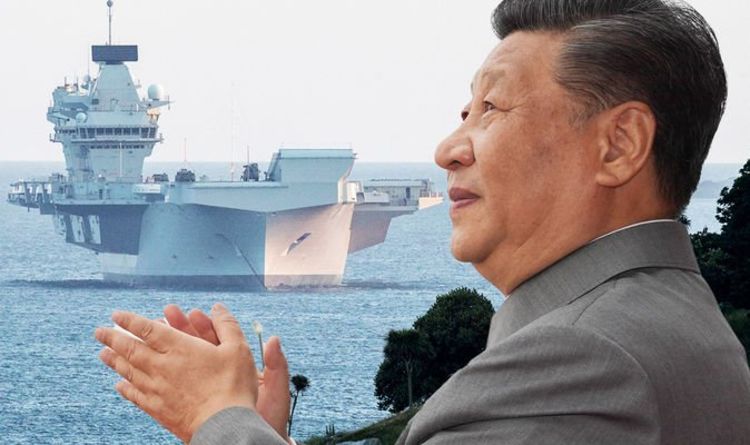China 'building infrastructure on South China Sea' says Hayton
We use your sign-up to provide content in ways you’ve consented to and to improve our understanding of you. This may include adverts from us and 3rd parties based on our understanding. You can unsubscribe at any time. More info
The South China Sea is a highly contested region and faces claims from China, Malaysia, Taiwan, Vietnam and the Philippines. Diplomatic relations between the nations are already extremely strained. Over recent months, Beijing has asserted its dominance in the region and has built several military bases on some of the atolls.
In a show of strength to Beijing, HSM Queen Elizabeth and her carrier group are set to sail through the contested region.
But Chinese state media has warned any vessels which stray too close to islands it lays claims to will be “expelled”.
A Beijing academic told state media that “China welcomes friends with wine but deals with wolves with a shotgun”.
The UK carrier strike group is currently on a round-the-world tour as part of her maiden voyage.


The vessels have already sailed through the Mediterranean to the Red Sea via the Suez canal and have taken part in joint military exercises with several nations.
This week, the £3billion ship sailed via the Malacca Strait to Singapore where they took part in joint drills before heading into the South China Sea.
It is believed the carrier will sail through the Taiwan Strait which is expected to spark anger in Beijing.
China’s state mouthpiece Global Times has warned Beijing will also carry out separate sets of military drills in the sea at the same time.

An expert told the newspaper: “While the Chinese military drills are not likely directly related to the UK warships, they show that the [navy] is at high combat readiness.
“Just like US warships that intruded Chinese islands and reefs in the region, if UK vessels do the same, they will also be expelled.”
A second expert added: “The [navy] will closely monitor the UK warships’ activities, stand ready to deal with any improper acts, and also see this as a chance for practice and for studying the UK’s latest warships up close.”
China’s warning to the UK comes after Beijing expelled an American warship after claiming it had illegally entered its territorial waters in the region.
DON’T MISS
Australia may be left to battle China ‘on their own’ – Taiwan war [INSIGHT]
Beijing accuses UK of ‘provoking’ China with HMS Queen Elizabeth [REVEAL]
South China Sea row: HMS Queen Elizabeth ignores Chinese threats [COMMENT]

Back in May, the Chinese military’s Southern Theatre Command said the USS Curtis Wilbur entered the waters near the Paracel Islands without permission.
It said the US action violated China’s sovereignty and undermined regional peace and stability.
However, the US Navy’s 7th Fleet said the vessel “asserted navigational rights and freedoms” near the Paracel Islands, over which China, Taiwan and Vietnam all claim sovereignty.
The Chinese military’s comments were false, it added.

HMS Queen Elizabeth will take part in Exercise Bersama Gold alongside Malaysia, Singapore, Australia and New Zealand after passing through the South China Sea.
Following joint exercises with the navy of Singapore, Commodore Steve Moorhouse who leads the carrier group said: “The Royal Navy has huge affection for Singapore based on our history together, but Singapore is also a beacon of enterprise in a region that is growing in strategic importance.
“The arrival of the Carrier Strike Group in Southeast Asia is a clear sign that the United Kingdom is ready to work with friends and partners, new and old, to strengthen the security and freedoms upon which we mutually depend.
“We are grateful to Singapore for supporting an important logistics stop for RFA Tidespring as the Carrier Strike Group continues our programme at sea.
“We look forward to working with Singapore again in the autumn for Exercise Bersama Gold, which marks the 50th Anniversary of the Five Power Defence Arrangements.”
Source: Read Full Article
